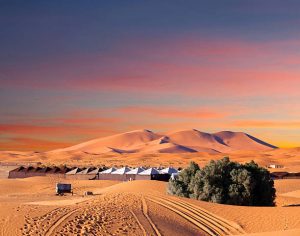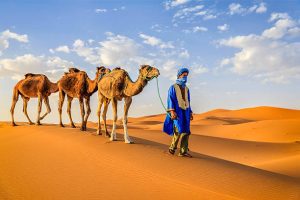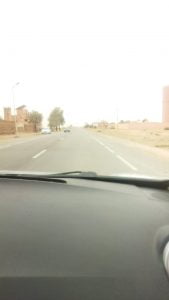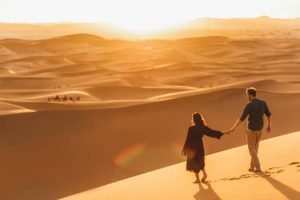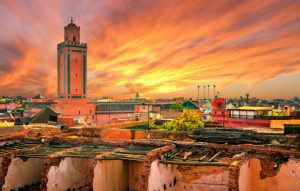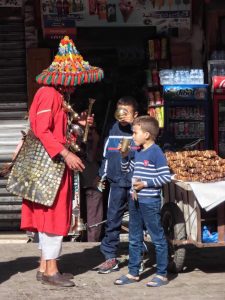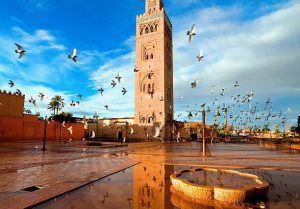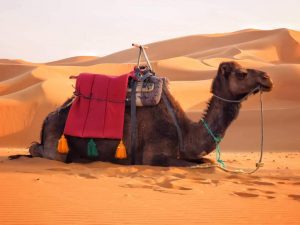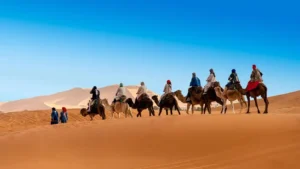Marrakech to Fes desert tour - 7 days(one week in Morocco)
Morocco Expedition offers Marrakech to Fes desert tour – 7 days(one week in Morocco)
About This Tour
- Destination : Fes
- Start From : Airport / accommodation in Marrakech.
- Return Location : Fes / Airport
- Departure Time : 8 AM
- Duration : 7 Days / 6 Night
Trip from Marrakech to Fes in 7 days includes and excludes the following activities:
Include :
- Pickup & dropoff service.
- English/Spanish speaking driver.
- Accommodation.
- 4 WD vehicle with fuel.
- Breakfast.
- Dinner.
- Camel for each in the desert.
Exclude :
- Plane ticket.
- Travel insurance.
- Monuments fees.
- Lunches.
- Tips.
- Drinks.
On a 7 days excursion, these are the top points of the itinerary:
- Marrakech with a local guide.
- The Fortress of Ait Benhaddou.
- High atlas mountains.
- Ouarzazate Atlas studio.
- Todgha Gorges.
- Merzouga camel ride.
- Camping at Erg Chebbi dunes.
- Fes, the cultural city.
- The desert tour.
7 Days desert trip from Marrakech to Fes itinerary's overview :
Experience the finest of Morocco in 7 days on a journey that takes you from Marrakech to Fes and across the desert. Spend the first two days of your trip seeing the city of Marrakech with a knowledgeable local guide. On day three, you’ll travel by several picturesque towns and Kasbahs including Ait Benhaddou and Ouarzazate on your way to Boumalne for the night.
The desert of Merzouga will occupy the better part of day four and all of day five. During your trip, you will camp out, ride a camel, and gaze at the stars. You will also go to meet the Berber Nomads and the Gnawa tribe on your exploration desert excursion.
Traveling to Fes in the last days of your trip will take you by many scenic areas, and on your final day, you may explore the city’s top attractions.
Feel free to get in touch with us to tailor this trip to your interests and set up your own individualized 7-day tour of Morocco starting in Marrakech.
Trip from Marrakech to Fes across the desert: Seven-Day Itinerary to Merzouga
Pickup and transfer to hotel on Day 1.
The first day begins with a convenient pick-up service at your hotel.
The first day of your seven-day trip will begin when you land. We’ll pick you up and take you to your lodging where you can unwind. If you were here early enough in the day, we could take a tour of Marrakech.
Marrakech sightseeing on day 2.
On day two of your seven-day (one week) trip from Marrakech to the desert city of Fes, you will have the opportunity to see the sights that have made this city famous. Your local guide will pick you up shortly after breakfast and transport you safely throughout the city. The Majorelle and Menara Gardens are our usual first stops.
Learn more about the fascinating past of these scenic areas, where locals often go for a break. As an example, Majorelle was created by a French artist who ultimately decided to make Morocco his permanent home. The second stop on our tour will be the historic city of Bahia and the El Badi Palace, two of the finest specimens of Moroccan architecture in the world.
We will eventually show you how the Saadians, who founded the city, created a kind of unique Tombs to bury their victims in. You’ll then visit the Koutoubia Mosque, home to Morocco’s tallest minaret. Finally, tonight is dedicated to touring the historic Jamaa El Fna square.
Trip from Marrakech to Boumaln Dades on Day 3.
Today, after breakfast, we’ll be on the road towards Boumalne Dades. The first part of our journey will take us through the High Atlas Mountains. Morocco has managed to construct a path through the mountains so that you may go to the southeast and reach the desert. From its beginning at the base of the High Atlas Mountains, this pass winds its way along a curving path for close to 200 kilometers.
As you make your way through the Tichka pass, be sure to pull over at the twistiest spot of the route ( about 2260m). A stunning view of the Atlas Mountains may be had from here. We shall soon resume our journey to the southeast, this time taking in the site of Ait Benhaddou along the way. You may take your time here, crossing the river to reach the massive Ksar that served as a major hub for camel caravans and merchants in the past.
A visit to Morocco’s Ouallywood is on on the itinerary for the afternoon. The Southeast of Morocco is without any major cities that have access to international airports, with Ouarzazate being the only exception. Our tour of the city will begin with a stop to the Atlas Studios, one of the city’s most popular tourist destinations. Location scouts and film crew members may also rent equipment there.
Back on the road again, our next stops will be at the Rose valley and the city of Kalaat Mgouna, both of which are well-known for their cosmetics. We will then continue on to Boumalne Dades, traveling through a number of picturesque Berber towns and valleys. We leave you here, and you eat supper and spend the night in a tent.
Our fourth day will take us from Boumalne Dades to Merzouga.
On day three of our seven-day desert journey from Marrakech to Fes via Merzouga, we will visit the destination that serves as the trip’s high point and, perhaps, of all Morocco desert vacations. But first, we’re going to check out some worthwhile spots, such the Toudgha or Toudra canyons, the greatest spot in the country for rock climbers at an altitude of roughly 300 meters. Furthermore, you’ll be traveling through several interesting urban centers like Tinghir and Tinejdad.
We may visit either Erfoud or Rissani cities if time permits. When we get to the Merzouga desert, it will be our last destination. We’re going to go right up to the camel that’s waiting by the sand dunes. Count on our staff of camel guys to ensure that your camel ride goes off without a hitch.
In a good attitude, we make our way through the golden sand dunes. Sunsets are best enjoyed in the desert camp, but if we’re running late, we’ll stop and take in the scenery along the route. The camp offers sandboarding and skiing once you get there. The Berber drums will play beneath the stars while you dine on a traditional Moroccan feast.
The fifth day of the trip is spent exploring the desert of Merzouga.
The fifth day of our one-week desert trip from Marrakech to Fes through Merzouga will be dedicated entirely to exploring the desert landscape. First, get up early on the morning of your vacation and climb some sand dunes to see a spectacular sunrise. Once you get back to camp, freshen up with a shower and then enjoy a hearty meal.
At some point, you’ll get in the 4×4 and go out into the desert in search of the nomadic Berbers who founded the city of Merzouga. These people still rely on the sale of their goats and sheep in nearby souks, most often in Erfoud and Rissani, for their survival. We’ll get in the car and go to M’Ifiss, where you can explore one of the region’s oldest kohl mines.
We will next drive you to Glb Nass, which translates to “the people’s heart” in English and is one of the few vantage points from which you can take in the picturesque landscapes of the desert. We will be leaving shortly for the town of Khamlia, which is approximately 4 kilometers from the heart of Merzouga. One way of life is contrasted with another here. Among the many things that make the Merzouga desert interesting to tourists is the presence of the Gnawa people.
For three days each year, this group of people throws a celebration they call the Gnawa festival. Now they perform traditional dances and songs in a variety of styles. We’ll be going to a spot called Dar Gnaoua once we get there. Here you may learn about their background and enjoy their songs. We’ll next go to an Emirati’s private museum in Morocco, where he displays a variety of vintage 4x4s.
The sixth day of the trip takes you from Merzouga to Fes.
Our Marrakech to Fes desert trip is scheduled to conclude at the cultural city, so on the sixth day, we will make our way there. To begin, right after breakfast back at basecamp or the hotel. About thirty to forty minutes’ drive from the desert brings us to Erfoud, which we want to explore. The city is known for its abundance of fossils, and we want to check out some of them. There will come a time when we resume our excursion and proceed for the Errachidia dam.
That river is the lifeblood of the Errachidia region and the surrounding desert. Moving further, we’ll keep on driving to Fes, this time going by way of Midelt and Zaida, two more stunning Moroccan towns. One of these two rooms will host the lunch buffet. We will stop for lunch and then continue on our journey to the cultural capital. Next up is a visit to the stunning cedar grove near Azrou. We’re going to go on a hike in this area in search of Barbary macaques.
In a few time, we’ll be off to Ifrane, Morocco’s “little Switzerland,” where the city’s namesake Atlas lion monument serves as the major point of interest. Our day’s journey will conclude when we reach Fes. We’ll drop you off at your lodging for the night so you can get some rest before seeing the city in the morning.
This is Day 7 of our trip to Fes, and we will be sightseeing across the city.
Our Marrakech to Fes desert trip (7 days) through Merzouga is a week long and concludes with a guided visit of Fes on the last day. As is well-known, Fes is one of the four imperial cities of Morocco. It goes without saying that the highlights of the area will be explored during this trip. You’ll start your exploration of Fes in the largest of the city’s three tanneries, the Chouara tannery. Tanneries have been around for a long time since they were the primary location for dying textiles and producing leather goods. Typically, after seeing the tanneries, we go to the world’s first and oldest university for a look around.
Fatima al-Fihri established the University of Al Qarawiyyin in 859, drawing students from all over the globe. A trip to the Jewish quarter (known as the Mellah) is on the itinerary at some point. Afterward, you’ll go to Fes’s historic medina to wander the winding alleyways there. There are, of course, many more things to do and see in Fes besides learning about the city’s history, and your local guide will help you find them all.
Reviews for a 7 days trip from Marrakech to Fes :
I'm at a loss for words.
There were 12 of us on the circuit that went across Morocco for 7 days, and it was incredible. Everything from the scenery to the locals to our expert guides and driver, Aziz and Hamid. Constantly ready to inform and amaze with tales of their amazing homeland. Seven days that I will never forget. Through the Atlas, Ouarzazate, Merzouga, the Dades Valley, the Toudgha Gorges, and the Erg Chebbi desert, we traveled in a group of three 4x4s with five adults and seven kids. Last but not least, we enjoyed supper with our guide and his family. They treated us like family and provided us with the nicest hospitality. Sleeping under the stars in the desert, exploring the desert by day and night, seeing oasis towns and meeting the desert’s indigenous inhabitants, the Berbers, were all highlights of the trip. This is fantastic in every way. We will return in the near future.
Marla R
December 2020
Many thanks!
This was my first time booking a private trip, and I expected to pay an arm and a leg to have our own personal Spanish-speaking driver and guide for a whole week. It was the finest choice I’ve ever made; we had a wonderful vacation thanks to the customized itinerary planned by Hamid and his team. Everything was well-planned, down to the reward of staying in excellent hotels and eating the kind of authentic food that is normally only available via the services of local guides. Despite being the coldest night of my life, spending the night in the camp in the desert was one of the most memorable of my life. The desert at night is peaceful and lovely, with the sky seeming dark blue rather than black because of the reflective quality of the sand. In my opinion, you won’t regret going on this vacation. That’s very helpful, Habibi.
Recardo A
January 2019
It was a fantastic trip with wonderful companions!
Our vacation was scheduled to go from Marrakech to Fes across the desert, and it would last for a total of seven days and six nights. We were a group of three, and Ali, our guide, made the whole week enjoyable and exciting. These guides are true experts in the desert and will show you the real side of the region. In addition, the accommodations we stayed in were top-notch. This tour company and vacation in Morocco were both highlights of our trip.
Alvaro G
December 2019
Have a question about the itinerary for the 7-day excursion from Marrakech to Fes?
Please feel free to contact us if you have any concerns about the 7 Days travel from Marrakech to Fes itinerary. Any inquiries you may have will be answered with pleasure by our staff.
A weeklong trip from Marrakech to Fes across the desert through Merzouga:
Desert of Merzouga
Touring the desert of Merzouga between Marrakech and Fes is the highlight of your seven-day desert adventure. The camel ride across the dunes is the highlight of the trip for the vast majority of our tour guests that come to Morocco. To begin, the name Merzouga originates from the Merzoug family, one of the first Nomad families to settle in the region’s desert. Others attribute it to the Arabic word for “rich” or “sort of blessed” (Mrzouqa), from whence the English term was derived. Famous for its golden sand dunes, Merzouga may be reached by traveling approximately 30 kilometers from Tighmert to the settlement of Khamlia.
Hassi Labied, Takojt, Tanamoust, and many more neighborhoods are often mentioned in place of Merzouga since they are all considered to be part of the larger urban area. Erg Chebbi is the name given to the desert in the vicinity of Merzouga, where there are large, bright golden sand dunes. However, if you go farther south, you’ll come upon a plethora of other, less-traveled deserts. As a first point of interest, the Znigui desert is just around 10 to 15 kilometers from Merzouga. But if you go farther into Ramlia and Jdaid, you will discover additional deserts that provide picturesque scenery due to their proximity to the surrounding mountains.
There are several reasons why the Merzouga desert is the most popular in the nation. One of the world’s tallest dunes may be found there, making it ideal for sports like sandboarding and other extreme sports. As an added bonus, the Erg Chebbi desert is home to some of the world’s finest golden dunes, perfect for camel rides and watching the sun set or rise. Even more, you may hire a quad or buggy to traverse the sand dunes, or you can even spend the night in a Berber tent in the desert.
Marrakech
The city of Marrakech, sometimes known as the “City of Light” or “The Red City,” is the most popular tourist destination in all of Morocco. In other words, almost all foreign visitors to the monarchy make time to see the city of Marrakech. Named after the Berber phrase for “the country of god” (Amur N Ukosh), the city’s origins may be traced back to that phrase. The city was originally populated by a number of dispersed Berber groups, but by 1147 had grown to become a regional and then national power center.
Marrakech’s greatness lies in the way its many different cultures and vivid hues come together there. There are many interesting and unusual sights to see on the Marrakech to Fes desert tour: Marrakech one week itinerary through Merzouga. The first is Jamaa El Fna, a plaza where people used to gather, sit in circles, and exchange tales. Since the square’s recent rise to international prominence, Moroccans from all across the country now go there to perform or sell their wares. The greatest thing to do here is to visit a café on an upper floor and watch the area below from above, where you’ll get a bird’s-eye view of the many light displays.
Second, it is well-known that Morocco is home to some of the world’s most impressive mosque minarets. The Almoravids, who established Marrakech in 1147, are responsible for the construction of the Koutoubia tower, which is often regarded as the finest example of Moroccan architecture. There are two Majorelle gardens and two Menara gardens, each with its own unique history and design. For instance, Jacques Majorelle spent almost forty years cultivating his famous garden, known as the Majorelle Garden.
To visit the Ait Benhaddou Kasbah:
Many people’s first mental image of Morocco is of a country whose buildings are made entirely of mud. Of course, the finest examples of this style of building are kasbahs. The Kasbahs of Ait Benhaddou are undeniably the most popular and impressive in the whole region. The spectacular ksar may be found on the route from Marrakech to Fes over the desert, just after passing the High Atlas Mountains. First, the family of Thami EL Glaoui owns the Kasbah.
They were one of the wealthiest families in Morocco’s history, according to certain studies, and this later family is very well-known for their extensive property holdings. They also own several additional estates, including the kasbahs of Telouet and Tamdaght, in addition to Ait Benhaddou.
In order to provide security for its mostly-merchant population, Ait Benhaddou’s ksar was constructed with a number of fortifications. Plus, the kasbah was formerly a major transportation hub in the region. The 52-day journey to Toumboctou by camel caravan ended with a stop here, when the camels’ major commodity—salt—was traded. Since the Arabic word for salt is lmelh, the little river that flows in front of the kasbah is also named the Ouad Lmelh.
Ait Benhaddou’s unusual architecture, with massive towers and imposing walls, continues to draw visitors from across the world. In fact, UNESCO recognized it as a world historic site in 1987. Parts of other blockbuster films, including Gladiator and Lawrence of Arabia, have also been filmed at Ait Benhaddou.
Ouarzazate
We leave the stunning Ait Benhaddou Kasbah and travel the next 30 kilometres to the city of Ouarzazate. Before delving into the city and its history, it’s important to define the name itself: Ouarzazate. It’s the location without noise, or the city without noise, and it’s made up of two different words: “Ouar” and “Zazate,” the first of which is Without and the second of which means noise. As the only city in southern Morocco with an international airport, it has become a popular starting point for desert trips in recent years. It lies midway between Marrakech and the Sahara, thus many people consider it the gateway to the desert.
One of Ouarzazate’s two top attractions is the Atlas Studios, which you should see if you’re there. Both the Oscar and CLA Atlas studios are located within 5–7 kilometers (5–10 miles) of the heart of Ouarzazate. They serve as the primary locations for filming and are also used to rent equipment for the crew. Tourists go to the Oscar studios instead because there are more unique attractions there, such as wooden automobiles and enormous figures reminiscent of ancient Egypt.
Some may be surprised to learn that Ouarzazate is home to the world’s largest solar concentration facility. This is indicative of the significance of clean, solar power in Morocco. Also, Ouarzazate is home to a large Kasbah designed something like a labyrinth, which is among the greatest there is to see. Great walls, towers, and over 300 chambers make this fortress worthy of a visit even if it receives fewer visitors than others of similar size and prominence.
Tour to the desert of Merzouga.
The greatest way to see the Sahara Desert of Merzouga is on a trip from Marrakech to Fes. On the fifth day, you’ll obviously do a lot of exploring in the desert and learn all about the best sights and hidden gems that the Moroccan Sahara has to offer. To begin, you will learn about the culture of the Berber people, the first to settle in what is now Morocco and Merzouga.
Ninety percent of the current population of Merzouga is descended from Nomads, meaning that they traditionally lived in tents and herded animals. Merzouga became one of Morocco’s most popular tourist destinations, prompting the establishment of hotels, riads, and tour operators there.
Next, we’ll show you a different way of living. The Gnawa are a distinctive cultural feature of the Merzouga desert. Historians believe these individuals were sent here from places like Gabon and Mali. The term “Gnawa” may have Berber roots, according to some. According to legend, the Gnawa people got their name because they made so much noise partying all the time that the Berbers would eventually order them to go to sleep by saying, “Gen Awa.” Some think the name derives from Agnawa, which means “the slave.”
In addition, the tour of the desert will take you past a little museum in the town of Tanamoust. The owner, an Emirati who also owns the Ksar next to the museum, has a collection of 4×4 vehicles on display here. The excursion also includes stops at some of Hassi Labied’s historic Oases.
Mountains of the Atlas range, including Tichka Pass and the Toudra Gorges
One of the longest mountain ranges in the world may be seen and crossed in the course of a weeklong trip that departs from Marrakech. As they are often separated by great distances, some people prefer not to refer to them as mountain chains. You may split these ranges into the High Atlas, the Middle Atlas, and the Anti Atlas in Morocco. Algeria and Tunisia have the High Atlas Mountains as their common border. The High Atlas Mountains and a tiny portion of the Anti will be the first major landmarks seen on the 7-day desert trek. The Middle Atlas Mountains will then be seen as you make your approach to Fes.
Getting from Marrakech to the Southeast or vice versa used to be difficult due to the mountains along the way. Although, in 1936, the French and the Moroccans built one of the longest curving highways in the country. A variety of Berber settlements and kasbahs dot the roughly 200-kilometer-long route; for example, you’ll stop to learn about an Argan oil cooperative. Another halt will be made at the pass’s highest panoramic point (2260m), from where you’ll get excellent views of the Atlas Mountains.
On the road from Boumalne Dades to the desert of Merzouga, you’ll pass through Toudra, also known as Toudgha Gorges. The 300-meter-or-so canyons here are a major tourist draw. Toudgha is, without a doubt, one of the finest locations in all of Morocco for rock climbing. Having a valley in between the canyons is obviously one of the things that elevates the beauty of this location. Traveling nomads and local Berbers bring their herds here to drink, and you may also encounter some of them selling goods like carpets.
Cedar trees in Ifrane
You may see Ifrane and the cedar grove on our desert excursion from Marrakech to Fes. One of the most pleasant climates in all of Africa may be found in the Middle Atlas Mountains, where the region known as “little Switzerland” is located. The climate of this city is quite different from that of the rest of the nation; in fact, it may be the coldest city in the United States. Each winter, it is decked up for the occasion and welcomes snowboarders from all over the world to Morocco. Skiers will find that Ifrane is also one of the cleanest cities in Morocco and all of Africa.
In memory of the now-extinct Atlas lion, Ifrane’s centerpiece is a monument of the animal. One legend has it that a German slave constructed it in order to buy his freedom. Plus, Ifrane is where the national soccer squad, the Atlas Lions, goes to be ready for contests. In addition, Al Akhawyin University, one of the most costly in the country, is located in Ifrane.
Cedar trees may be seen not too far from Ifrane. This stunning region used to be home to a wide variety of species, many of which are now extinct. The Barbary macaque is a popular attraction for visitors who come to the area to wander and see the primate.
Fes
Often referred to as the “culture center of Morocco,” Fes is the country’s second-largest metropolis. Our trip over the desert from Marrakech ends at Fes, which is located in the northeastern part of the country. There is no doubt that this metropolis had a significant impact on the growth and development of the nation. Not to mention the fact that, along with Marrakech and Meknes, it is one of Morocco’s imperial cities and the present capital, Rabat.
The cultural city was established during the eighth and ninth centuries and served as a major trading hub. You will be blown away by the city’s vibrant colors and intricate architecture when you explore it with a knowledgeable native. This city is a superb example of traditional Moroccan design. Fes has 11 gates, but the one most people enter through is Bab Boujloud, which was constructed in 1913 and is considered the city’s main entrance. The name Boujloud is derived from the Arabic term bab el junud, which means “father of the warriors” in English.
Some of the other attractions in Fes are the Chouarra tanner. Of the city’s three tanneries, this one is the largest and oldest. Built in the 11th century, it served as a tannery where leather was processed by treading barefoot on animal skin before being dyed. Products were formerly colored with spices, but today’s manufacturers instead employ chemical paints. In addition, Fes houses the world’s first and only university established by a woman. As is well-known, Morocco was formerly home to a sizable Jewish population, and in Fes, as well as many other major towns, you may visit the area that they once called home. Mellah Quarters is the Moroccan term for such neighborhoods. At long last, you can find the finest Hammams in this city.
Itineraries similar to the 7 days travel from Marrakech to Fes
What follows are examples of itineraries for the finest bespoke tours in Morocco, which you should give some thought to. If the trip you choose isn’t listed, however, you can always use our inquiry form to make together your own Morocco vacation package.


